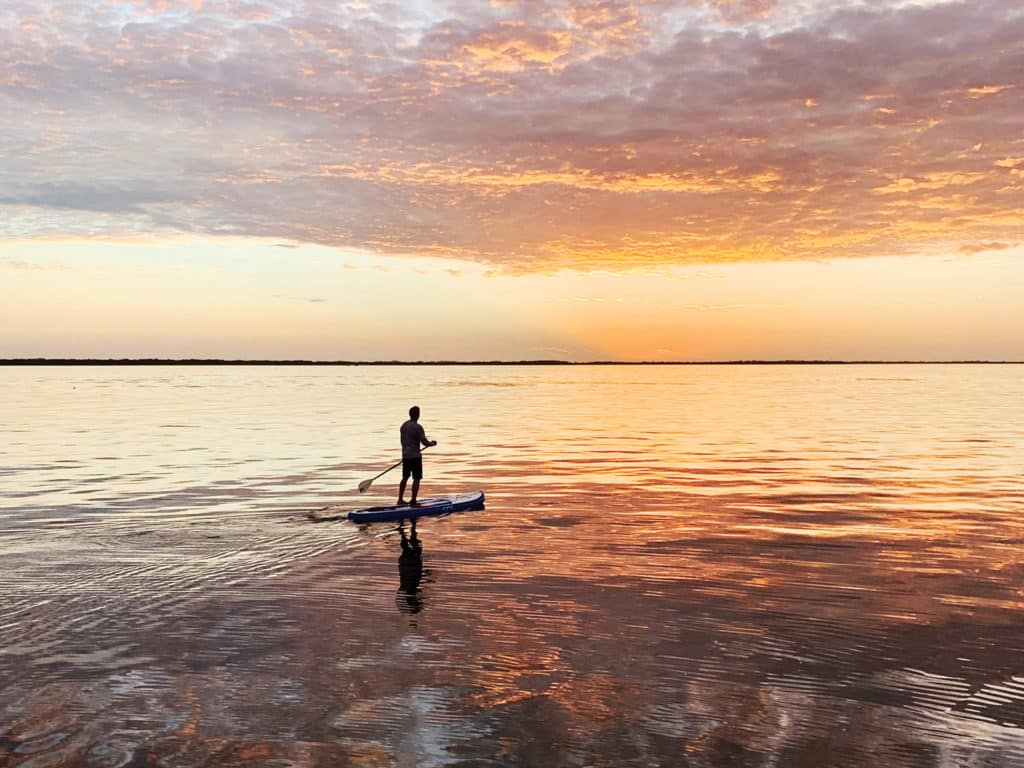
Making landfall in southeast Florida can be a shock to a sailor’s system: a barrage of fishing-boat wakes, ceaseless cars and dial-a-lawyer billboards. It feels at times as though someone invited over millions of people, turned up the sound, and left all the lights on. But Florida also has a sweeter, slower-paced side, as the crew of Liberte, our Beneteau 361, discovered in our latest explorations.
Over the course of eight leisurely weeks, my wife, Rebecca, and I cruised the heartlands of the Caloosahatchee River and Okeechobee Waterway, poked around Pine Island Sound, sailed Charlotte Harbor and visited Punta Gorda, then went south along the Everglades. This route brought fascinating human and critter encounters, beaches with no footprints, and night after night of wildly pleasing west-coast sunsets.
Rebecca and I have been cruising our boat Liberte every winter for 10 seasons now. We set out from Bellingham, Washington, in 2009 and eventually transited the Panama Canal. For the past three years, we’ve hauled out in Florida for the summer. Then, right after sharing a snowy Christmas in Idaho, we’ve flown into Fort Lauderdale, stayed with friends while we launched and commissioned the boat, then lounged about in sunny Stuart on Florida’s east coast while waiting for a favorable Gulf Stream crossing to the Abacos or sometimes the Exumas. Those Bahamian waters are mind-blowing, and nobody could blame us if we continued that same migration year after year, as did many of the sailors we met.
But the wanderlust that brought us all these miles was hard to ignore. So after we launched Liberte at Indiantown Marina in early January 2019, we headed west for new waters. Our first challenge loomed low. The Port Mayaca Railroad Bridge, at the eastern entrance to Lake Okeechobee, is normally listed at 49 feet above water, and Liberte has an air height of 49.5 feet, plus instruments. These numbers haunted my midnight hours, and lately I’d been obsessively refreshing the U.S. Army Corps of Engineers link for Lake Okeechobee water levels. A dearth of rainfall would help us sneak under, and a deluge would make the bridge impassible.
Plan B was to hire local innovator Billy the Tipper to heel our boat using drums lashed to the rail and filled with canal water. I had also schemed various ways to crack the nut ourselves, using, say, the tender at the end of the boom, loaded with water or anchor chain. To be honest, those rinky-dink solutions always ended badly in my mind’s eye.
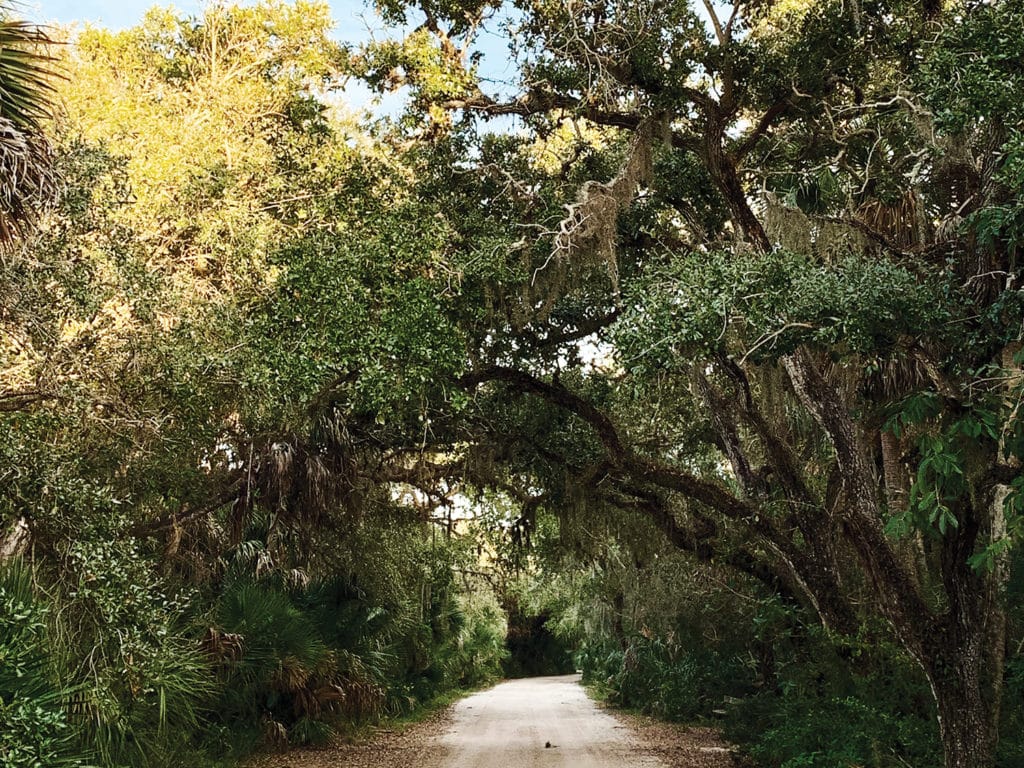
We crept up to the bridge, and even though the website said we had a foot to spare, it sure looked like a no-go. As sailors on a Pacific Northwest boat, we had seen very few bridges before arriving in Florida, and crossing under the Golden Gate Bridge did not prepare us for this. As Rebecca and I peered skyward, we had a lively will-we-make-it, no-we-won’t discussion, but there was no crash as we went slowly forward, only the tick-tick-tick of the VHF antenna brushing rusty railway steel overhead. We were free to ramble onward.
At nearby Mayaca Locks, we met the first of the characters who keep this stretch of waterway rolling. The gruff but talkative lockmaster with a Texas drawl entertained us for the few minutes it took to lock up to Lake Okeechobee. Here, the numbers were on our side again—the lake was deep enough. I’d read accounts of boats crossing in shallow water and high winds while being dropped onto the keel in every wave trough, which didn’t sound like fun. That day we had Goldilocks conditions. The water was low enough to get us under the bridge and high enough to float our 5-foot draft safely.
RELATED: Boot Key Charm
We even had a nice little afternoon sail in north winds around 10 knots, and finished the 22-mile crossing just before sunset, nosing up just outside the lake to a side tie at Roland and Ann Martins Marina & Resort just off the main channel. The dockmaster called me “Captain” and Rebecca “Mrs. Captain.” He lived aboard a small boat festooned in American flags, and said he was working the docks until he could save up enough money to head out again and chase some sunsets of his own. We of course gave him a tip for his cruising fund.
The next day we motored along a wide, placid section of the canal, passing one alligator after another on the banks. Apart from bass-fishing boats, there was very little traffic, which came in handy when we suddenly needed to sail. Our engine temp alarm sounded, so Rebecca shut down the engine and I rolled out the jib. I found a coolant leak at the top of the water pump, patched it with gasket-maker (while playing hot potato with the metal parts), and let it cure while we coasted along in the lovely sunshine. That evening’s five-star accommodations were in Moore Haven, where the waterway turns into the Caloosahatchee Canal. We pulled Liberte up to the seawall, walked 100 yards to city hall and paid our buck a foot. We found a pair of tree frogs still hitching a ride aboard the boat from Indiantown and carried them to the park.
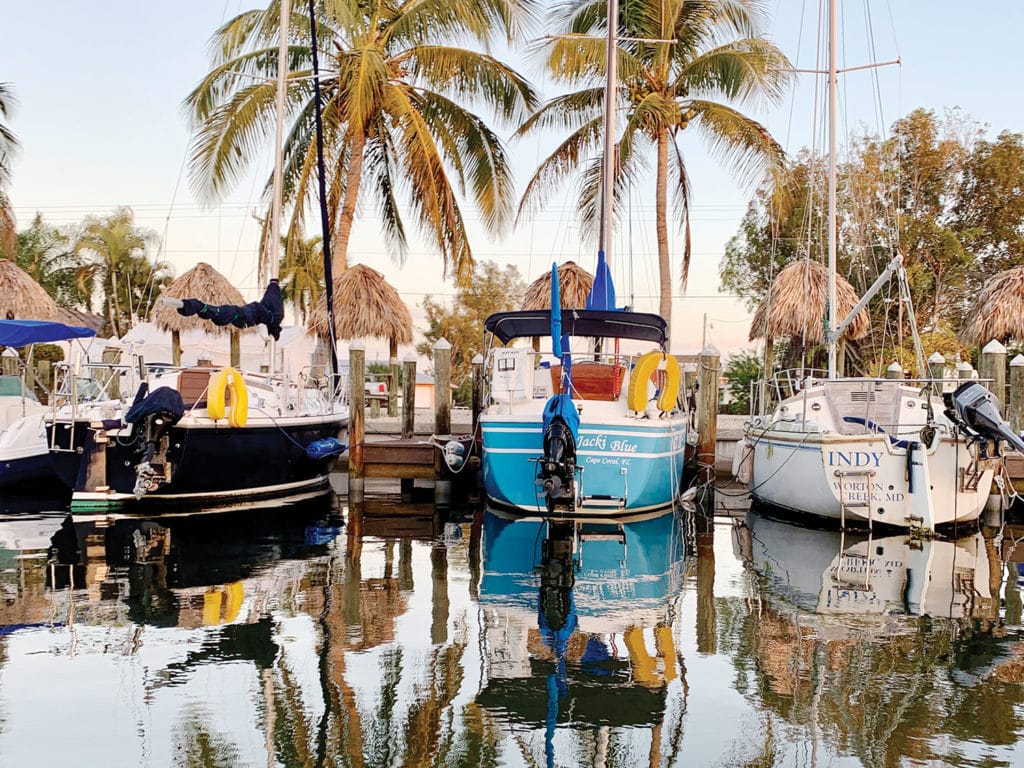
The price was even better at our next overnight, the LaBelle City Wharf, where we’d read we could stay free for three days including power and water. Those docks were full, so we headed across the canal to Bob Mason Town Park, where we ended up spending two quiet nights. Rebecca and I walked daily across the bridge and through the friendly town under big oak trees hanging with moss, and returned to the boat carrying propane and groceries on our backs.
Liberte continued our unhurried pace west, the waterway now named the Caloosahatchee River. We were delighted by the lady bridgekeeper who carried a parasol and admonished us kindly, “You kids stay warm, now” on a morning that was easily 70 degrees. This was a pleasant countryside, with the kinds of houses that make you think, “Hey, we could live there,” mingled with orange groves.
We motored on, once again squinting straight into the sun (a downside of westbound travel in the late afternoon), and reached Fort Myers with just enough light to thread the white stakes marking the channel to the mooring field. We launched our dinghy using the spinnaker halyard to hoist it off the foredeck and the main halyard to lower the engine. The 4 hp Mercury fired right up after its long summer layup, and we gave hoots of joy.
We dinghied in to pay for our mooring, and Rebecca reported that the marina shore shower ranked a 10 out of 10. “It has hot water, good pressure, it’s clean, and there are places to hang your stuff,” she exalted. She smelled good, and I took her out on the town by walking a few blocks to the upscale River District, where we found gourmet tacos and live music. It was uncomfortably cold going back to the boat, a reminder of how chilly Florida winters can be. We had learned in previous seasons here to pack jackets, hats and even socks, although I tend to view putting on socks any time of year as a sure sign of defeat.
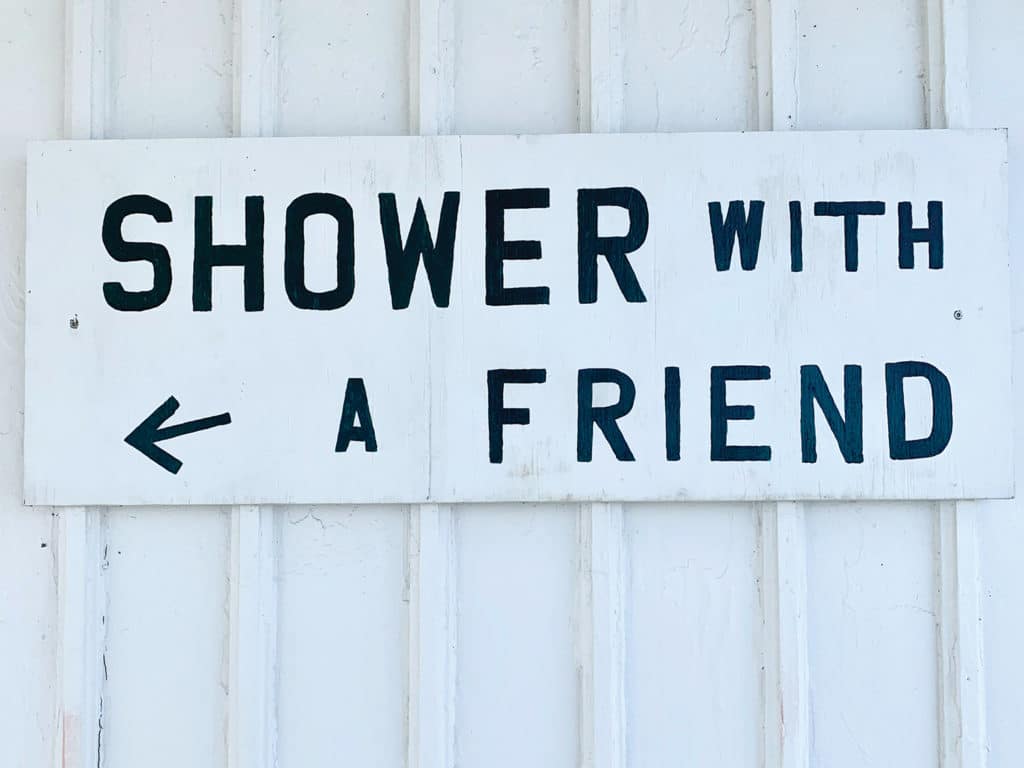
I wanted to make a better water-pump repair, so we booked a couple of nights at Cape Coral Godman Yacht Basin, across the river in Cape Coral. We enjoyed the pool and small beach, and watched every sunset from the Boat House Tiki Bar. We walked in to town for the Saturday farmers market, and then hailed the free Nickel Ride, with a big man named Tiny bringing us back to Liberte. I replaced the water pump with our spare, and we upgraded our six-year-old Trojan T105 house batteries, which bulged around the terminals. A local vendor dropped the new batteries by as I lugged him our old ones, easy as could be.
What a feeling of freedom to cast off and head for nearby Pine Island Sound with our systems sorted, our boat provisioned to the gills, and our spirits ready to explore. We sat back and watched the sunset show from our anchorage off St. James City with particular satisfaction. This was the first of many places we would choose on this trip using the Navionics boating app, where other sailors leave notes on anchorages, marinas and hazards. It proved a handy source of information throughout our travels.
Our next anchorage was 17 miles north via the Intracoastal Waterway. We kept the red marks to starboard—“Red right returning to Texas,” as the saying went—and stayed in the channel to avoid the dredge spoils on either side. Pelican Bay at Cayo Costa State Park had come up in every conversation about Pine Island Sound, and we approached with a sense of anticipation. The narrow, unmarked entrance hugs the beach, and we found plenty of room to anchor with 20 or so other boats.
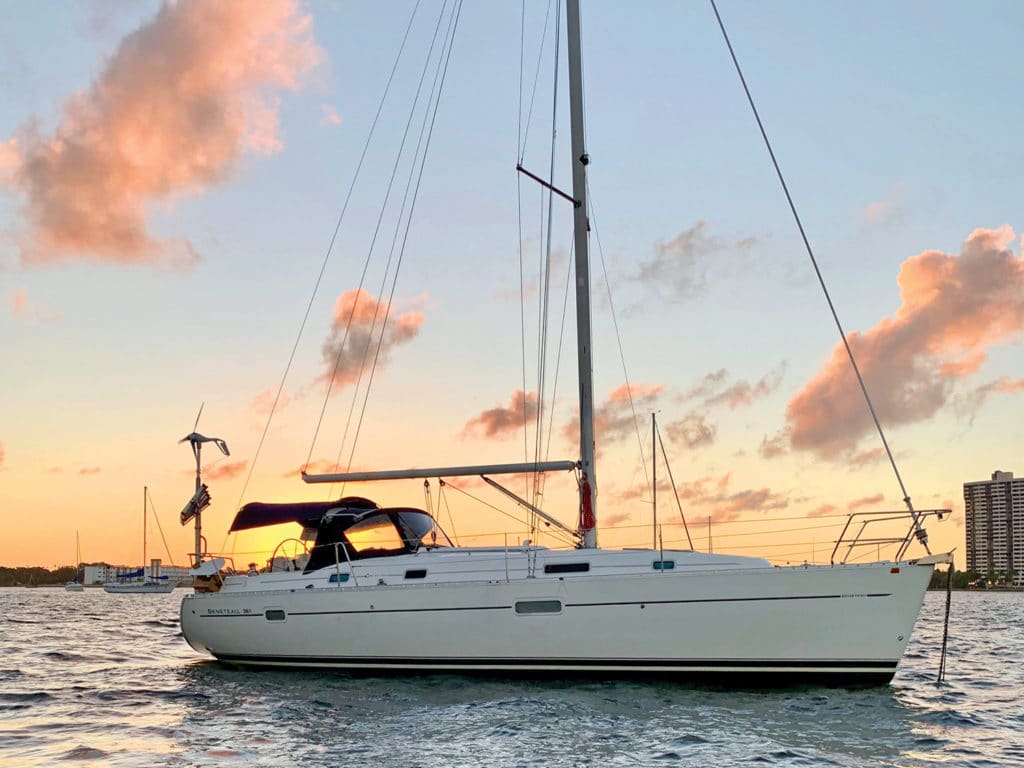
Since we began cruising Liberte, we have loved the contrast our boat provides of spending a few days in civilization and then heading out for more-remote places. The Canadian Provincial Parks spoiled us in this regard. So did the Sea of Cortez, the Las Perlas and San Blas islands of Panama, and the outer atolls of Belize. Here, in one of America’s most densely populated states, we were once again living the dream: anchored in a wild, beautiful place, rowing ashore for a beach workout and shell hunt, and returning to Liberte to enjoy chimichurri egg tacos for lunch, while photons flew 93 million miles to warm our skin and power our simple needs.
At Cayo Costa, we could tie the dinghy to the park dock, put our $2-per-sailor entrance fee in the box, and walk a mile on a sandy path across to the Gulf of Mexico side of the island, where a lovely beach stretched as far as we wanted to go. In our daily rambles, Rebecca and I saw pine, cactus, palmetto and oak trees in pleasing juxtaposition, and spotted new flowers and birds. This was a pace and place we could have enjoyed for days, or even weeks. But weather was coming, and although Pelican Bay is a sheltered anchorage in most conditions, we were happy to accept an invitation from friends in nearby Punta Gorda.
Charlotte Harbor is renowned for good sailing, and Liberte had a splendid 16-mile romp in a southerly breeze. We reluctantly struck sails outside Ponce de Leon Inlet. Punta Gorda has several good marinas, but better yet, our friends had welcomed us to tie up at their dock in the canals. The tide had just turned and we were unsure about depth, and as we deliberated, out of the channel came a sistership, another Beneteau 361, with the owner smiling and saying, “Don’t worry, you’ll be fine.” If only every entrance could have such a cheerful oracle of local knowledge.
We motored through the canal system, ogling homes and boats along the way. What a treat to see Lori and Tom again, cruising friends we’d met on the Pacific side. We made a fine home at their dock for a few days while the weather raged. Tom cooked insanely good barbecue, and Lori told stories of growing up in Italy. Punta Gorda has 55 miles of canals, a nearly nonexistent crime rate, and a charming downtown and waterfront. Like many places we’ve visited while sailing, it was hard to leave.
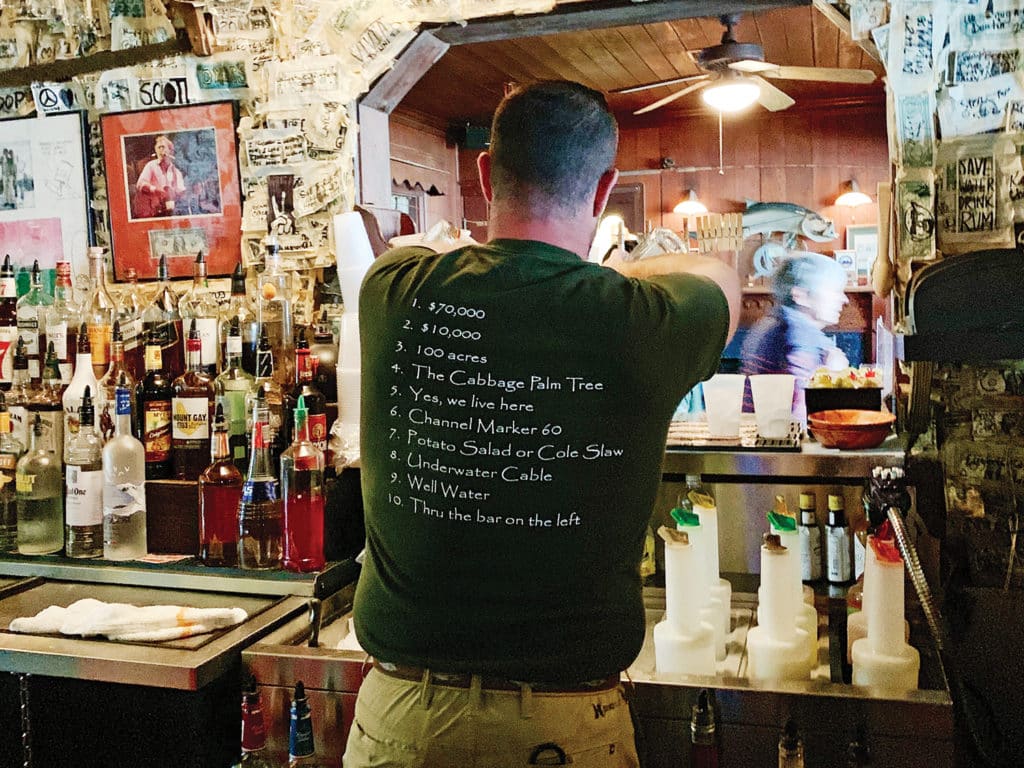
The weather passed, and with the wind back to the prevailing northeasterly, we had another glorious reach retracing our route across Charlotte Harbor. Just after dusk, we dropped the hook off the private island of Useppa, avoiding the cable areas on the chart. A fragrant wind came from shore, little lights twinkled, and we seemed quite far from the worries and cares of the rest of the world. The boat rocked and rolled in a couple of passing wakes, and then we had the place to ourselves.
Ah, Cabbage Key, with its Inn & Restaurant, and all the places only a boat can take you! It was a bright sunlit morning as the dockmaster helped us tie up the dinghy and we scrambled ashore, eager to get the measure of the place. The gift shop was tempting and the nature trail beckoned, but Rebecca once again had the smart play. “Let’s grab a table now,” she whispered, and sure enough, right about the time we tucked into our shrimp and potato salad lunch and Cabbage Creeper drinks (the local favorite), our island was invaded. Tour boats and private boats arrived by the dozens, then people came ashore looking hungry and thirsty. We gave up our table in good etiquette, and had a prowl around the place, another couple of Cabbage Creepers in hand, looking for Jimmy Buffett’s dollar bill. Fortunately, it’s framed behind the bar, because the walls and ceiling are thick with layer upon layer of bills, signed by visitors the world over. Our bartender’s T-shirt listed answers to the most frequent visitor questions, including the fact that $70,000 is taped to the walls and $10,000 falls off each year (and is donated to charity). We added our own dollar bill, inscribed with Liberte, our names and our favorite sailing toast, “We’re all here because we’re not all there.”
We escaped the crowds by climbing the island’s water tower, where if we squinted, we could imagine the boats that had come before: Calusa and Seminole canoes, Cuban fishing craft, and elegant wood runabouts with wealthy dropouts, artists and writers, film stars and dignitaries, island owners and castaways. Near the tower, two of the charming local tortoises were working on making the next generation of tortoises, but the male was getting nowhere fast. I chased Rebecca around the nature trail, which took us over a shell midden, the high point of the island where shells cast here by ancient inhabitants still crunched under our feet.
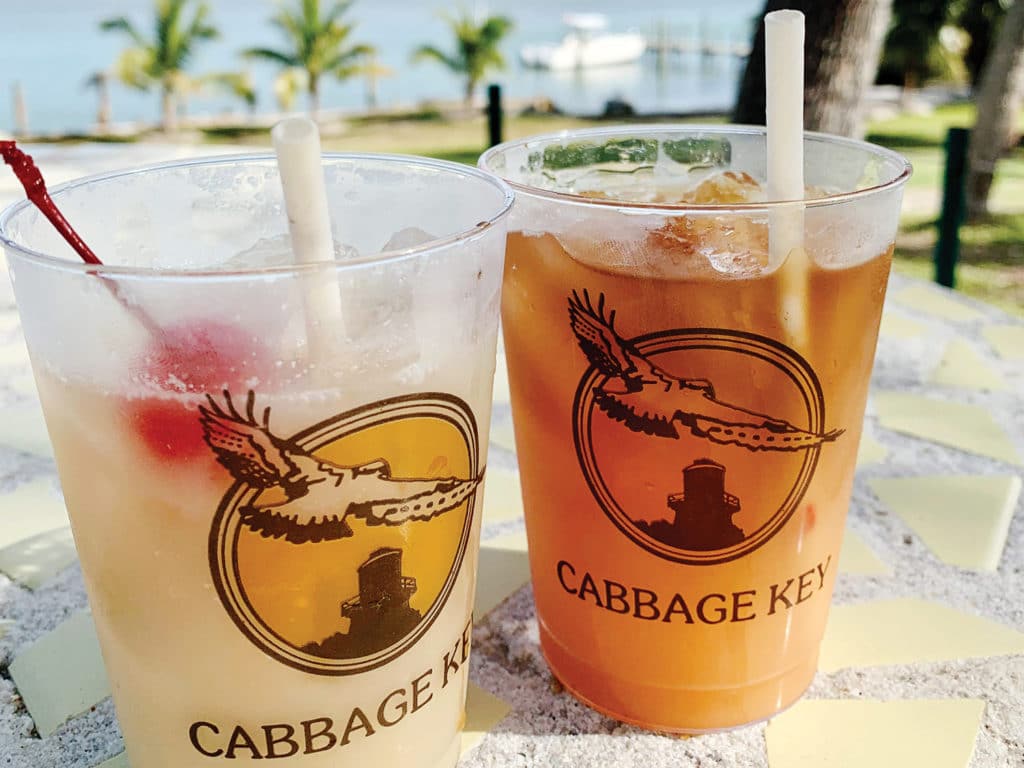
Then it was back to the yacht and south to an inauspicious afternoon. We’d managed to keep Liberte off the bottom all this time, despite the shoal depths that sometimes had us tiptoeing gingerly through skinny waters as we sang the new Lady Gaga song from A Star Is Born: “In the shallows, the sha-ha-lowwws…”
Happily abuzz with our Cabbage Island outing, exultant in the sunshine, and egged on by what turned out to be dodgy advice from a longtime local mariner, we took a gamble we wouldn’t have ordinarily taken, and parked our boat soundly atop a sandbar in midchannel to Captiva Island. We applied plenty of rpm in reverse, then in forward, with no results. I unfurled the jib to heel the boat in the wind and Rebecca gave it full revs again, but it was obvious we were here to stay for a while. We’d made the mistake of not leaving ourselves the margins we normally do. Captiva was to be our shelter for the night with southerly weather coming, and now the tide was going to turn and it would soon be dark.
I called TowBoatUS for the first time ever and asked for help. In fact, it was the only time in 15 years of owning and extensively cruising Liberte that we’d needed this kind of assistance. But sooner or later, as they say, there are two kinds of sailors, those who have been aground and those who lie about it. So consider this my true sailing confession.
Fortunately our Gold Unlimited membership meant there’d be no charge. But there was an interminable wait, and when our rescuer arrived in fading light, we found out why. They had been pulling boats off the bottom all day due to southerly winds affecting the depths and time of tides in the sound. With the tugboat straining and our boat heeled way over, there was a lurching release, and, we were finally free—(with shouts of triumph) a remarkably joyous sensation unrivaled in humdrum daily existence.
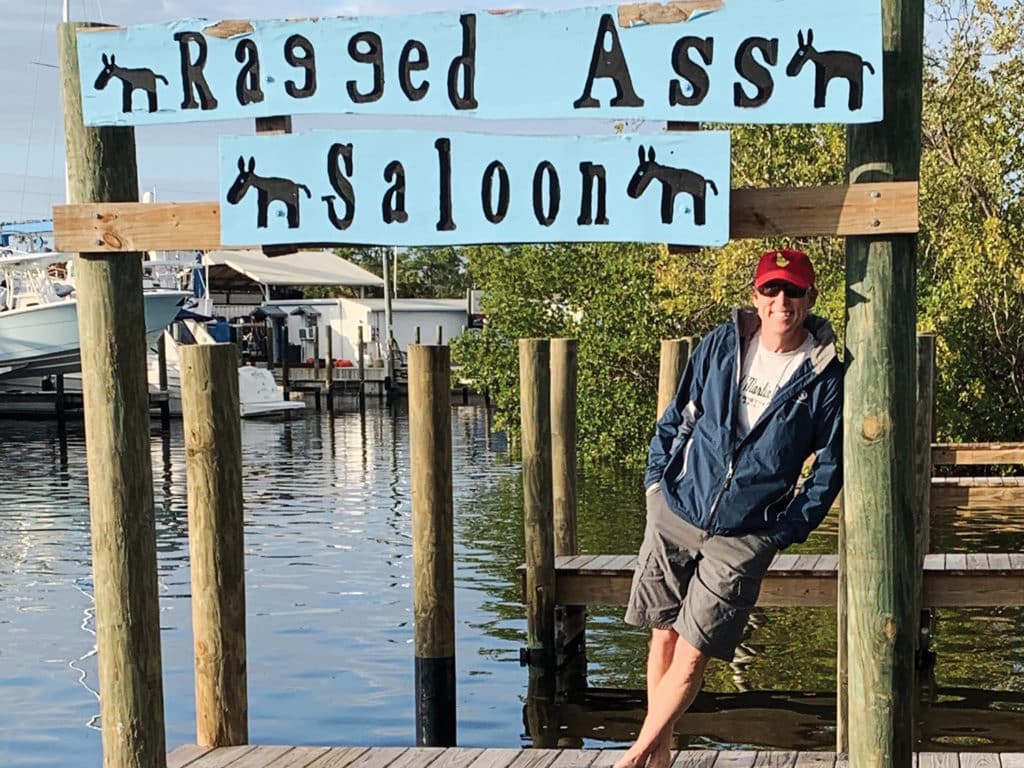
We made the most of that freedom with the rest of our time in the Florida sunshine. Sailing friends Marie and Bill flew in, and we picked them up for a best-of-the-islands itinerary. As we left Pine Island Sound to go south, we encountered fog we hadn’t seen since San Francisco. Now dodging crab pots, the constant watch in these waters, became a more interesting game. The fog cleared as we made the channel to Factory Bay on the north end of Marco Island, where we took a slip, walked to West Marine and the grocery store, and watched the Super Bowl.
The contrast was stunning the very next night, when we were the only boat anchored north of Indian Key in the Everglades. No condos, no crowds—just the moon, stars, water and our cozy floating home, which now seemed much bigger than when tied to the dock among the behemoths. The next morning as we sipped our coffee, the pelicans put on a stellar fishing exhibition, joined by osprey and an eagle.
The Everglades treated us right, with few bugs and no other boats. Rebecca and I celebrated a milestone anniversary at Cape Sable, another marvelously remote anchorage. We’d married 20 years ago on a beach in the Grenadines and run off on a sailboat, so this was the very best place we could be. We hadn’t even pulled the dinghy ashore before the ladies were squealing with joy. Strolling the beach at low tide, they found handful after handful of bright shells: Sunray Venus, Turkey Wing, Paper Fig, Lettered Olive, Lightning Whelk and many more. I went on ahead, and found the tracks of sea turtles and something far bigger. South Florida is the only place in the world where alligators and crocodiles coexist, and while I pondered these tracks all alone, I felt the thrill of astonishment.
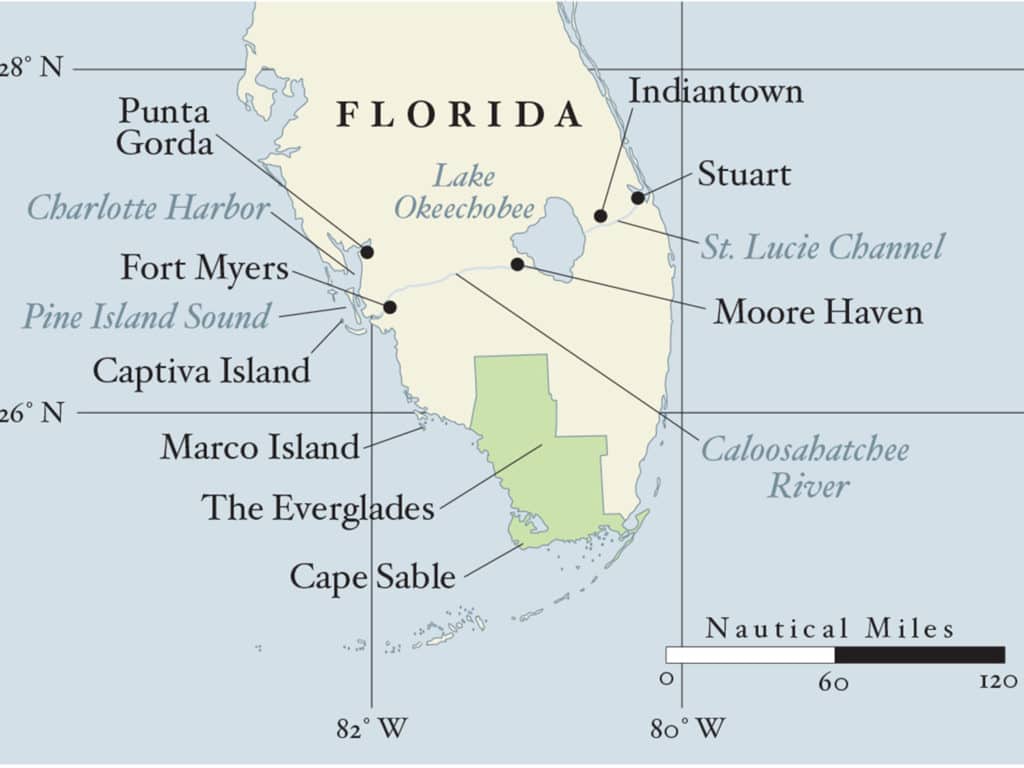
As we watched another epic sunset from the cockpit and saw the stars come out, we felt the pulse of our own planet beneath us. The only sign of civilization was the glow of Key West. We were spoiled beyond measure, once again rewarded for pointing the bow toward new places, just to see what we’d find.
David Kilmer spends his summers running the 60-foot daysailer Sizzler in Coeur d’Alene, Idaho, and his winters by the sea, cruising warmer waters.








